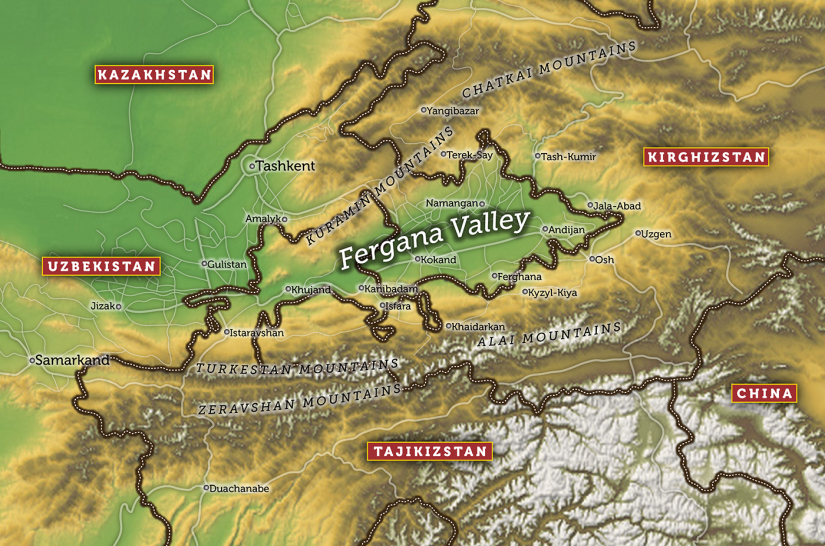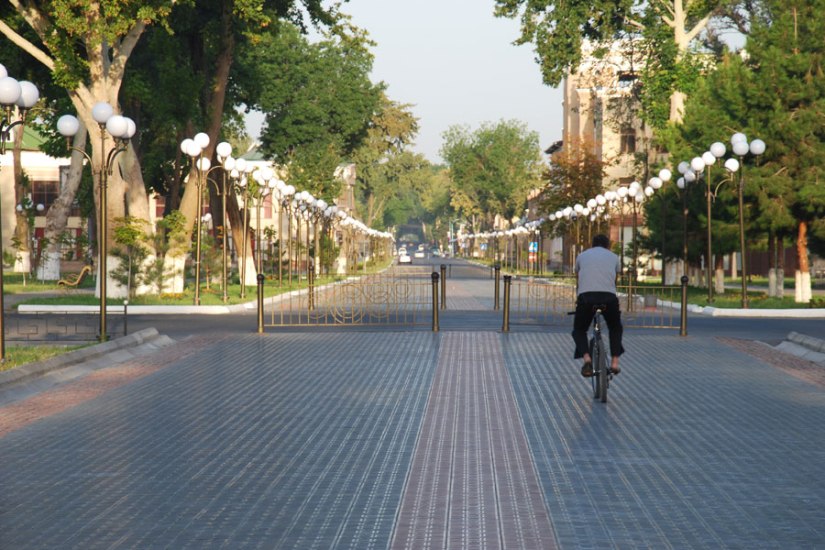Kokand (sometimes spelled Khoqand) is located in eastern Uzbekistan, at the southwestern edge of the Fergana Valley. It is the main transportation junction in the Fergana Valley and has a population of about 200,000 . The city lies 228 km southeast of Tashkent, 115 kmwest of Andijan, and 180 km west of Osh, Kyrygystan. and 210 km southwst of Jalal-Abad, Kyrgyzstan.
Kokand is at the crossroads of the two main ancient trade routes into the Fergana Valley, one leading northwest over the mountains to Tashkent, and the other west through Khujand. and the Khujand Gates out of the Fergana Valley
It is nicknamed “City of Winds”, or sometimes “Town of the Boar”, derived from the tribal family group of “Kokan” who belong to the Kongrat tribe of Uzbeks.
The Khanate of Kokand was a Central Asian state in Fergana Valley that existed from 1709–1876 within the territory of modern Kyrgyzstan, eastern Uzbekistan Tajikistan, and southeastern Kazakhstan.

Kokand on the Silk Road
Kokand has existed since at least the 10th century, under the name of Khavakand, and was frequently mentioned in traveler’s accounts of the caravan route between India and China. The Han Dynasty of China conquered the entire city in the 1st Century B.C. Later, the Arabs reconquered the region from Tang Empire. The Mongols destroyed Kokand in the 13th century.

The present city began as a fort in 1732 on the site of another older fortress called Eski-Kurgan. In 1740, it became the capital of an Uzbek kingdom, the Khanate of Kokand, which reached as far as Kyzylorda to the west and Bishkek to the northeast. Kokand was also the major religious center of the Fergana Valley, boasting more than 300 mosques.

Russian imperial forces under Mikhail Skobelev captured the city in 1883 which then became part of Russian Turkistan. It was the capital of the short-lived (1917–18) anti-Bolshevik Provisional Government of Autonomous Turkistan (also known as Kokand Autonomy).They sought co-operation from Ataman Dutov and Alash Orda. However, their emissary to the Amir of Bukhara achieved little.
What to See in Kokand
x
Palace of Khudayar Khan

The Palace of Khudayar Khan was built between 1863 and 1874 by Muhammad Khudayar Khan. Upon completion, it was one of the largest and most opulent palaces in Central Asia. Nineteen of its original one hundred and thirteen rooms survive and now host a museum.
The Palace Complex constructed in 1871 by sixteen thousand conscripted or enslaved workers using one thousand carts to transport materials, the eighty master builders designed and built an ornate structure of variegated colors and rich ornaments with geometric patterns, arabesques, and floral motifs all made from ceramic tiles and based on tales of the Orient. 
Jummi Mosque
a Friday mosque built in 1800-1812, and reopened in 1989, it can hold 10,000 worshipers.
Amin Beg Madrassah
built in 1813.
Dakhma-I-Shokhon
a necropolis of the Kokand Khans from the 1830s.
Khamza Museum
dedicated to Kokand’s Soviet hero Hamza Hakimzade Niyazi.
Education and Culture
Islam a plays large role in the cultural life of Kokand. A number of madrasah can be found with the city. It is also home to a number of notable hanafi scholars, such as Abdulhafiz Al-Quqoniy and Yorqinjon Qori Al-Quqoniy. Cultural attractions in Kokand include:
- 2 institutes,
- 9 colleges and lyceums,
- 40 secondary schools,
- 5 musical schools,
- a theater,
- 20 libraries.
- 7 historical and house museums

3 thoughts on “Kokand”